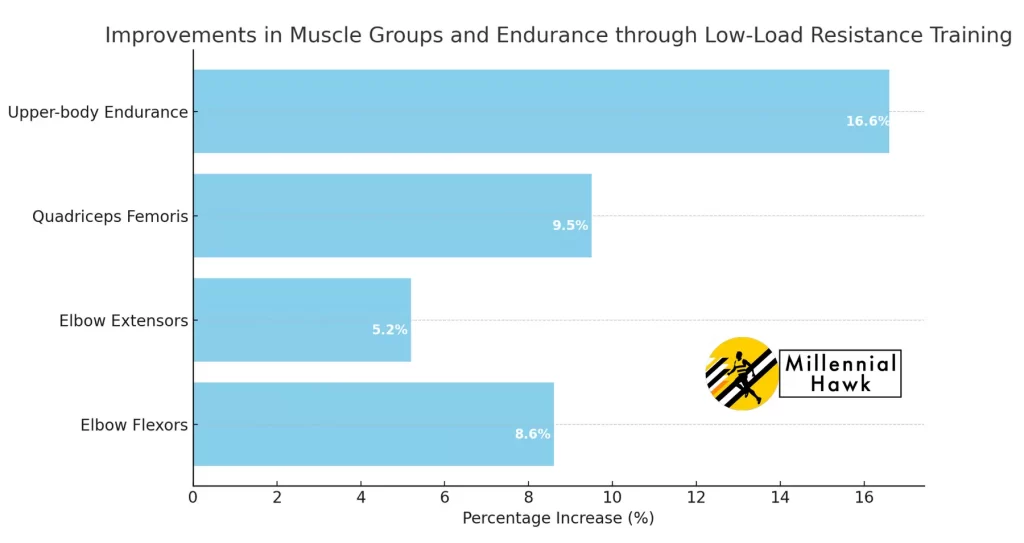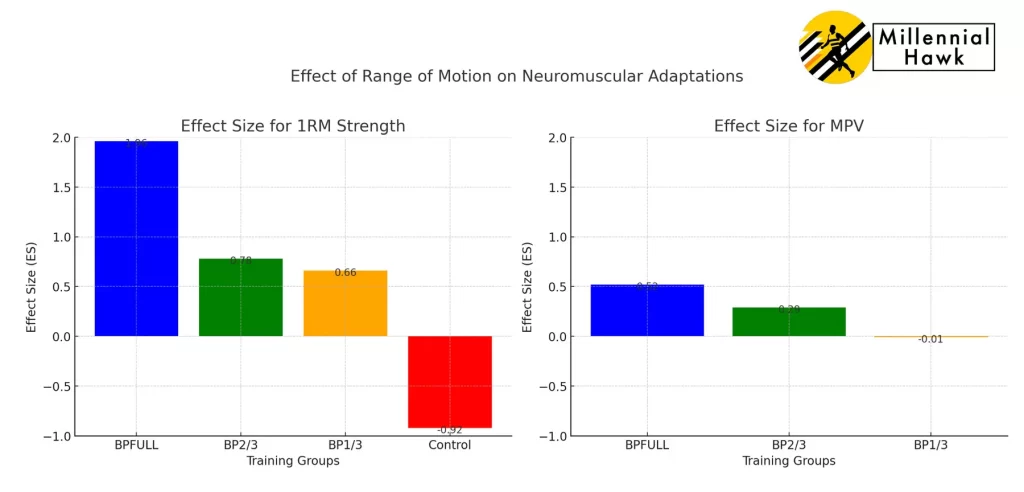Bench pressing 500 pounds (approximately 226.8 kilograms) refers to the act of lifting a barbell for one or more reps loaded with a total weight of 500 pounds or 226.8 kilograms (five plates on each side) while lying on a bench. This exercise targets the chest, triceps, and shoulders for maximum strength and muscle development.
To bench press five plates (approximately 495 pounds plus the bar weight, totaling 500 pounds), a specialized training plan that integrates both foundational and advanced resistance training techniques is essential. According to the 2019 study by Michal Krzysztofik, effective hypertrophy-oriented resistance training should include a blend of mechanical tension and metabolic stress, suggesting the use of advanced techniques like drop sets, accentuated eccentric work, and blood flow restriction in addition to traditional training protocols.
Utilize a periodized training plan that incorporates different rep and set schemes, varying intensities, and focuses on key muscle groups like the chest, triceps, and shoulders. Always consult with a certified strength and conditioning coach to personalize your training and ensure that you’re following a safe and effective program to reach your goal of a 500-pound bench press.
This article covers the 9 steps required to bench press 500 pounds and also explains the time commitment involved, the benefits and risks, how it compares to world records, and how to structure your workout plan to bench 500 pounds.
- Test and log your 1RM
- Follow a triceps-focused weekly program
- Mix in maximal and dynamic effort days
- Include chest and back exercises
- Rotate exercises and grips
- Add high-rep, low-weight sets
- Consult a coach for form
- Increase weight gradually
- Schedule check-ups and rest
1. Test and log your 1RM
Test and log your 1RM refers to the process of determining your maximum capability for a single repetition of the bench press exercise under professional supervision, and recording this value for future reference.
According to a 2012 study by Dong-Il Seo from Dongguk University, the one-repetition maximum (1RM) test is considered the gold standard for assessing muscle strength in non-laboratory settings, emphasizing its reliability as a measure. The study also highlights that a standardized 1RM testing protocol is reliable for assessing muscle strength changes, making it crucial for tracking your progress toward a 500-pound bench press goal. Importantly, the reliability was consistent regardless of muscle group location or gender, making it a universal measure of strength capabilities.
To test and log your 1RM, under professional supervision, perform a standardized 1RM test for the bench press, which includes a short warm-up and familiarization period. Record the maximum weight you can lift for a single repetition, and use this value as a baseline for tracking your progress.
2. Follow a triceps-focused weekly program
A triceps-focused weekly program involves incorporating triceps-strengthening exercises like board presses, rack lock-outs, and triceps extensions into your weekly bench press training routine. These exercises are specifically designed to target the triceps brachii muscles, which are essential for achieving a high-level bench press.
According to the 2017 study by Déborah de Araújo Farias from Rio de Janeiro Federal University, muscle activation patterns vary depending on the mode of bench press performed. The study indicated that when a triceps extension exercise was performed after different modes of bench press, the barbell bench press elicited significantly greater triceps brachii activity. Specifically, the training volume for triceps extension was greater by 9.74% after barbell bench press compared to after using a Smith machine, highlighting the importance of triceps activation for achieving higher bench press volumes.
To follow a triceps-focused weekly program, incorporate at least 2-3 triceps-specific exercises like board presses, rack lock-outs, or triceps extensions into your weekly training routine. Perform 4 sets of each exercise with a 10-repetition maximum (10RM) load, taking a 2-minute rest interval between sets, as suggested by the study.
3. Mix in maximal and dynamic effort days
Mixing in maximal and dynamic effort days refers to incorporating two types of training days into your bench press routine: one focused on lifting the maximum weight you can (maximal effort) and another focused on lifting lighter weights as quickly as possible (dynamic effort). The maximal effort days aim to increase your one-repetition maximum (1RM), while dynamic effort days aim to improve the speed and explosiveness of your lift.
According to the 2019 study by Michal Krzysztofik, effective hypertrophy-oriented resistance training should combine mechanical tension and metabolic stress, both of which can be targeted through maximal and dynamic effort days. Maximal effort days create a high degree of mechanical tension, essential for muscle growth and strength, which is crucial when aiming for a 500-pound bench press. Dynamic effort days focus on speed-strength, allowing you to lift a given weight more explosively, thereby improving your performance across the entire force-velocity curve, a key metric in strength training.
For maximal effort days, aim to lift close to your 1RM, doing sets consisting of low repetitions (1-3) with weights ranging from 90-100% of your 1RM. For dynamic effort days, perform sets with lighter weights (about 50-60% of your 1RM) for higher repetitions (8-12), focusing on lifting the weights as quickly as possible.
4. Include chest and back exercises
Including chest and back exercises means incorporating additional strength training exercises that specifically target the pectoral (chest) and latissimus dorsi (upper back) muscles into your workout routine. Examples of back exercises you can include are pull-ups, bent-over rows, and lat pulldowns. For the chest, include exercises like dumbbell flyes or push-ups into your routine, aiming for 3 sets of 8-12 reps. For the back, add exercises like barbell rows or pull-ups, also aiming for 3 sets of 8-12 reps.
These exercises complement the bench press by strengthening the muscle groups that assist or stabilize the movement, thus improving your ability to push heavier weights.
Based on the 2019 research published in the International Journal of Environmental Research and Public Health by Dr. Krzysztofik, a successful resistance training program aimed at muscle hypertrophy should incorporate both mechanical tension and metabolic stress. These elements can be effectively covered by including accessory exercises in the regimen. Accessory work targeting the chest and back helps in muscle cross-sectional area growth, which is directly correlated to muscle strength, thereby contributing to reaching the 500-pound benchmark.
The study emphasizes the need for well-rounded training to break through plateaus, and a failure to train these assisting muscle groups may lead to imbalances and plateaus, hindering progress toward a 500-pound bench press.
5. Rotate exercises and grips
“Rotate exercises and grips” means periodically changing the types of bench press exercises you perform and the width of the grip you use on the barbell. This can include variations like close-grip, medium-grip, and wide-grip bench presses, as well as incorporating different bench angles and techniques.
According to a 2021 study by Atle Hole Saeterbakken from Western Norway University of Applied Sciences, grip width significantly impacts muscle activation and the six-repetition maximum (6-RM) loads in both resistance-trained and novice-trained men. Specifically, biceps brachii activity increased with wider grips, while wide grips displayed lower triceps brachii activation than medium and narrow grips. Both groups demonstrated lower 6-RM loads using a narrow grip, which suggests that varying grip widths can target different muscle groups and potentially lead to stronger and more balanced muscular development.
To rotate exercises and grips, start by incorporating different grip widths into your bench press routine, moving from narrow to medium to wide grips over different training sessions. You can also include variations like incline or decline bench presses to engage different muscle groups. This video shows tips on how to rotate bench press grips.
6. Add high-rep, low-weight sets
In the context of aiming for a 500-pound bench press, adding high-rep, low-weight sets means incorporating sets with a large number of repetitions (25-35) using relatively low weights into your training regimen.
Based on a 2015 study by Brad J Schoenfeld from CUNY Lehman College, low-load resistance training with 25-35 reps per set led to significant muscle growth. This was comparable to the results from high-load resistance training with 8-12 reps per set. Specifically, the low-load resistance training group experienced an 8.6% increase in elbow flexor thickness, a 5.2% increase in elbow extensor thickness, and a 9.5% increase in quadriceps femoris thickness. Moreover, low-load resistance training boosted upper-body muscle endurance by 16.6%, highlighting its effectiveness in improving both muscle size and endurance, important factors for overall performance and joint health, as illustrated in this diagram.

To add high-rep, low-weight sets to your bench press routine, select a weight that allows you to perform 25-35 repetitions to failure for 3 sets. Perform these sets on a designated day or at the end of your regular bench press workout.
7. Consult a coach for form
Consulting a coach for form means seeking expert guidance to ensure that your bench press technique is biomechanically sound and efficient. A certified coach can provide real-time feedback and corrections to optimize your lifting mechanics, which is crucial when aiming for a 500-pound bench press.
In a 2022 study by Alejandro Martínez-Cava from the University of Murcia, it was found that training with proper form at a full range of motion led to more significant neuromuscular adaptations compared to partial ROM. Training groups that used a partial range of motion demonstrated smaller gains, as shown in this diagram.

As a result, improper form could impede your progress toward achieving a 500-pound bench press and may also increase the risk of injury.
Schedule regular sessions with a certified strength and conditioning coach who specializes in bench press training. During these sessions, perform your bench press under the coach’s supervision, adhering to their real-time feedback and subsequent exercise prescriptions to improve your form.
8. Increase weight gradually
Increasing weight gradually refers to the principle of progressive overload, where you systematically add more weight to the barbell over time to increase neuromuscular demand and promote strength gains. This tactic aims to help you reach your goal of a 500-pound bench press by continually challenging your muscles to adapt to higher loads.
According to the 2022 study by Daniel Plotkin and Max Coleman, increasing load while keeping repetitions constant (LOAD group) saw dynamic strength increases that favored this method by 2.0 kg, suggesting that load progression is effective for strength gains.
Although the study found that both increasing repetitions and load are viable for muscular adaptations, the slight favor towards dynamic strength in the LOAD group (2.0 kg) indicates that increasing weight may have a specific advantage for those targeting maximal strength, such as a 500-pound bench press. Importantly, the LOAD group participants had at least 1 year of consistent lower body resistance training, implying that for experienced lifters aiming for high-level strength goals, increasing load is a validated approach.
To increase weight gradually, start with a weight that you can lift for a set number of repetitions, say 5 reps, and aim to perform 3-5 sets. Each training session or week, aim to slightly increase the weight—by about 2.5 to 5 pounds—while maintaining the same number of repetitions and sets.
9. Schedule check-ups and rest
Scheduling check-ups and rest means periodic consultation with healthcare providers to assess your physical condition and the planned incorporation of rest days and deload weeks into your training regimen. This ensures that you are medically fit to handle the physical stress like a 500-pound bench press and provides your body with the necessary recovery time.
According to Dr. Krzysztofik, advanced resistance training techniques can create significant stress on the body, necessitating regular health assessments to prevent injuries. Dr. Krzysztofik also emphasizes the significance of managing mechanical tension and metabolic stress, which can be optimized by incorporating rest days and deload weeks to achieve muscle hypertrophy and peak performance. Without proper rest and medical check-ups, you risk not only injury but also suboptimal performance, as adequate recovery is crucial for muscle growth and strength gains.
To schedule check-ups, consult healthcare providers every 2-3 months for a comprehensive assessment of your joint health, muscle balance, and overall well-being. For rest, include at least one full rest day per week and plan a deload week every 4-6 weeks where you reduce training intensity and volume.
How long does it take to bench press 500 pounds?
Achieving a 500-pound bench press is a long-term goal that varies from individual to individual, but research indicates that performing a single set of 6-12 repetitions with loads of 70-85% 1RM, 2-3 times per week, can result in an average increase of 8.25 kg (approximately 18 pounds) in bench press 1RM over 8-12 weeks for trained men. Given this rate of improvement, it could take several years of consistent, specialized training to reach a 500-pound bench press from a moderate starting point, such as a 300-pound bench press. It’s crucial to note that these estimates are based on suboptimal yet significant increases in strength and may not directly apply to highly trained athletes or specific populations.
How long does it take for a beginner to bench press 500 pounds?
Reaching a 500-pound bench press is a long-term aspiration for beginners, requiring potentially 5-10 years of committed training, based on the improvement rates cited above. While consistent and optimal training conditions are assumed, individual outcomes can differ significantly.
What are the advantages of bench pressing 500 pounds?
The advantages of bench pressing 500 pounds extend beyond sheer strength; they also include substantial muscle growth and the capacity to lift heavier weights in various other exercises and activities. Additionally, the general benefits of bench pressing encompass increased muscle mass, the rectification of muscular imbalances, improved bone density, and enhanced overall strength and performance.
What are the risks associated with bench pressing 500 pounds?
Lifting 500 pounds in a bench press is very risky, especially when you compare it to what most people are doing in the gym. A study in 2022 found that about 1 out of 20 men in the U.S. Army got hurt while lifting weights over a year. The risk of getting hurt goes up as you get older. For example, men aged 23-27 are about twice as likely to get injured compared to those who are 22 or younger. Also, the more you train each week, the higher your risk of getting hurt.
What should you avoid when trying to bench press 500 pounds?
To avoid injury when trying to bench press 500 pounds, steer clear of aggressive use of free weights, always train under professional supervision, and prioritize proper weightlifting techniques.
Is it necessary to have a spotter when attempting to bench press 500 pounds?
Yes, it is necessary to have a spotter when attempting to bench press 500 pounds. According to a 2019 study in the Journal of Strength and Conditioning Research, the presence of spotters significantly improved bench press performance by increasing the total repetitions by 4.5 reps and the total weight lifted by 209.6 kg. Having a spotter also reduced the ratings of perceived exertion and increased self-efficacy, making it not only beneficial for performance but also potentially safer.
How should one warm up before attempting to bench press 500 pounds?
To warm up before attempting to bench press 500 pounds, one should follow a two-stage warm-up based on the study’s findings. First, perform 2 sets of 6 repetitions at 40% of your training load. Then, perform another 2 sets of 6 repetitions at 80% of your training load. This warm-up strategy, designated as WU in the study, was shown to optimize time to peak velocity and total work in bench press exercises.
How can I plan workouts to bench 500 pounds?
To reach a 500-pound bench press, your bench press workout routine should consist of three weekly sessions: one for maximal effort, lifting 85-100% of your current 1RM; one for dynamic effort, lifting 50-60% of your 1RM with speed; and one focused on accessory work like triceps board presses and upper-back exercises. Aim to increase your 1RM by at least 5% every month and monitor progress with monthly 1RM tests. Schedule regular health check-ups and include at least two rest or deload weeks per quarter for optimal recovery.
How does a 500-pound bench press compare to the world record?
A 500-pound bench press falls significantly short of the world record bench press, which stands at 1,401 pounds. The world record is more than double the weight of a 500-pound bench press. Achieving a 500-pound bench press is still an impressive feat, but it is nowhere near the level of strength and power displayed by the current world record holder.

